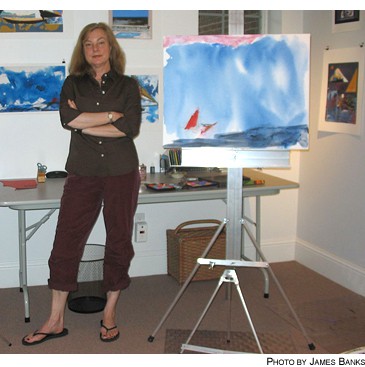(article formatted for printing - acrobat pdf file)
Provincetown Banner, August 2, 2007
Jeannie Motherwell Unlocks the Ghost of the Patricia Marie
Jeannie Motherwell, second generation Provincetown painter, is at the top of her game as she throws red, blue and black acrylics on a wet surface, creating layered textures that call to mind an explosion of pent-up anguish. To this she sparingly adds torn collaged fragments and boat-like hieroglyphs. The result appears as spontaneous and unpredictable as the sea.
For her first solo show at the Lyman-Eyer Gallery, Motherwell has created "Patricia Marie," opening with an artist's reception at 7 p.m. on Friday, Aug. 3, and remaining on view through Aug. 16. Lyman-Eyer is at 432 Commercial St., Provincetown.
Motherwell's restrained, luminous series of close to 20 paintings and collages are both a personal response and a public memorial to the sinking in October 1976 of the Patricia Marie as it headed for home, its hold heavy with scallops. Its captain and all six crewmembers were lost.
The sinking of the Patricia Marie happened early in Motherwell's first winter in Provincetown, and for 30 years the loss haunted her. She was 20-something, fresh out of college and the Art Students League, meeting local, people, dancing at Piggy's, getting around by bike, painting in her studio, after a childhood of dappled East End summers surrounded by an artist family (her father is Robert Motherwell and stepmother Helen Frankenthaler, icons of abstract expressionism), she was on her own, and feeling like a townie.
She had made a friend of dark haired fisherman Bobby Zawalick, one of the younger crew members of the Patricia Marie. She remembers the morning when she passed the Foc'sle (a popular bar in the town center, now the location of the Squealing Pig) headed to the bike trails; there was Zawalick in the door, asking if she'd join him for a beer. After a minute's hesitation shed joined him for a soda. What she remembers is his "smile that lit up the room," and the thick wad of $100 bills in his wallet: "It must have been thousands of dollars; and he said, 'Here I have all this money and I can't even give it away.' When the boat went down, the wallet was the first thing found belonging to Bobby Zawalick."
"I was only there for a few minutes," she says, "and when I mentioned that we should get together again soon, he said he'd be going out again early the next morning, and be gone for several days. It gave me a glimpse into his world, the constant coming and going, at sea, at land, the dedication."
 Jeannie Motherwell, who will open a show on Friday, is shown here in her studio.
Jeannie Motherwell, who will open a show on Friday, is shown here in her studio.
For Motherwell the tragedy was a creative turning point. She mourned along with the community, and as she continued to paint, she located an abstract subject matter that came from her, even though it took several decades to decode the small abstract triangular shapes in her collages. Not the sailboats of her sunny girlhood her friends imagined, or the picturesque draggers lining the wharf, but the ghost of the Patricia Marie. In Motherwell's "Abyss," streaks of loosely applied red washes into a raging black sea. A tornado-like black cloud hovers over in the right corner; as a blue rectangle seems to fall into the sea, the red sky parts slightly to reveal the shape of a white hull barely skimming the horizon line, as if the paint itself is hungry for a miracle.
The abstraction "Center Stage" has the expressive boldness of Chinese calligraphy. Splashes of black that could be boats hug the center of the picture; a torn piece of paper from one of Motherwell's earlier boat paintings forms a third image of a boat tossed by a raging sea. All elements are beautifully balanced, as if to hold the boat aloft even as it is ravaged by the sea. Motherwell thinks that even after she completes the Patricia Marie series, its sudden cataclysm will remain in her work as memory and feeling. She likens her series to her father Robert Motherwell's "Elegy to the Spanish Republic," consisting of hundreds of pieces done in memory of those who fought and died in the Spanish Civil War, a shattering event for Robert Motherwell's generation. "The boat is in my skin," she says. After three decades of trying to name her subject, Motherwell pulled from deep within her core and emerged with her own elegy conveying the unspeakable horror of that day.

Recent Comments